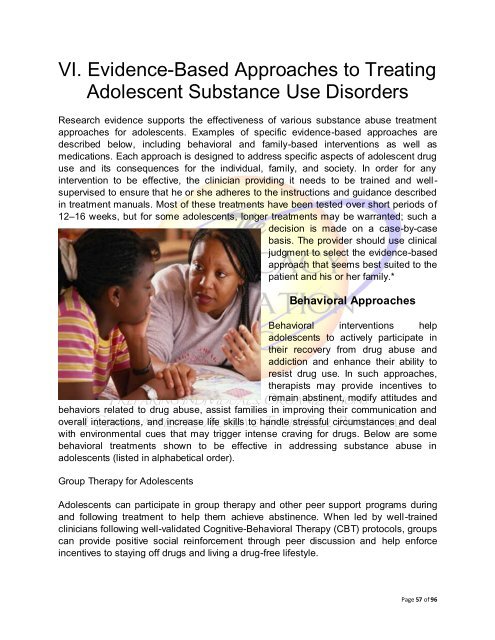The Opioid Crisis in America - Part IV (Drug Abuse Among America's Teens)
The Opioid Crisis in America - Part IV (Drug Abuse Among America's Teens)
The Opioid Crisis in America - Part IV (Drug Abuse Among America's Teens)
Create successful ePaper yourself
Turn your PDF publications into a flip-book with our unique Google optimized e-Paper software.
VI. Evidence-Based Approaches to Treat<strong>in</strong>g<br />
Adolescent Substance Use Disorders<br />
Research evidence supports the effectiveness of various substance abuse treatment<br />
approaches for adolescents. Examples of specific evidence-based approaches are<br />
described below, <strong>in</strong>clud<strong>in</strong>g behavioral and family-based <strong>in</strong>terventions as well as<br />
medications. Each approach is designed to address specific aspects of adolescent drug<br />
use and its consequences for the <strong>in</strong>dividual, family, and society. In order for any<br />
<strong>in</strong>tervention to be effective, the cl<strong>in</strong>ician provid<strong>in</strong>g it needs to be tra<strong>in</strong>ed and wellsupervised<br />
to ensure that he or she adheres to the <strong>in</strong>structions and guidance described<br />
<strong>in</strong> treatment manuals. Most of these treatments have been tested over short periods of<br />
12–16 weeks, but for some adolescents, longer treatments may be warranted; such a<br />
decision is made on a case-by-case<br />
basis. <strong>The</strong> provider should use cl<strong>in</strong>ical<br />
judgment to select the evidence-based<br />
approach that seems best suited to the<br />
patient and his or her family.*<br />
Behavioral Approaches<br />
Behavioral <strong>in</strong>terventions help<br />
adolescents to actively participate <strong>in</strong><br />
their recovery from drug abuse and<br />
addiction and enhance their ability to<br />
resist drug use. In such approaches,<br />
therapists may provide <strong>in</strong>centives to<br />
rema<strong>in</strong> abst<strong>in</strong>ent, modify attitudes and<br />
behaviors related to drug abuse, assist families <strong>in</strong> improv<strong>in</strong>g their communication and<br />
overall <strong>in</strong>teractions, and <strong>in</strong>crease life skills to handle stressful circumstances and deal<br />
with environmental cues that may trigger <strong>in</strong>tense crav<strong>in</strong>g for drugs. Below are some<br />
behavioral treatments shown to be effective <strong>in</strong> address<strong>in</strong>g substance abuse <strong>in</strong><br />
adolescents (listed <strong>in</strong> alphabetical order).<br />
Group <strong>The</strong>rapy for Adolescents<br />
Adolescents can participate <strong>in</strong> group therapy and other peer support programs dur<strong>in</strong>g<br />
and follow<strong>in</strong>g treatment to help them achieve abst<strong>in</strong>ence. When led by well-tra<strong>in</strong>ed<br />
cl<strong>in</strong>icians follow<strong>in</strong>g well-validated Cognitive-Behavioral <strong>The</strong>rapy (CBT) protocols, groups<br />
can provide positive social re<strong>in</strong>forcement through peer discussion and help enforce<br />
<strong>in</strong>centives to stay<strong>in</strong>g off drugs and liv<strong>in</strong>g a drug-free lifestyle.<br />
Page 57 of 96

















